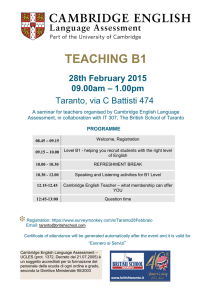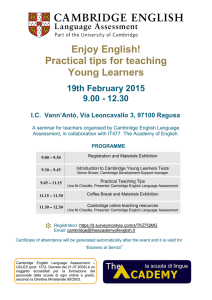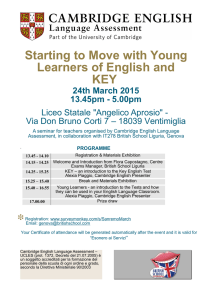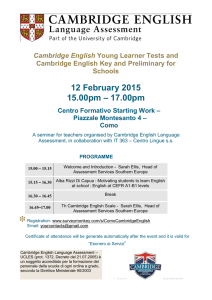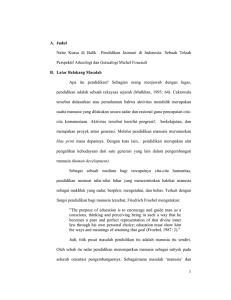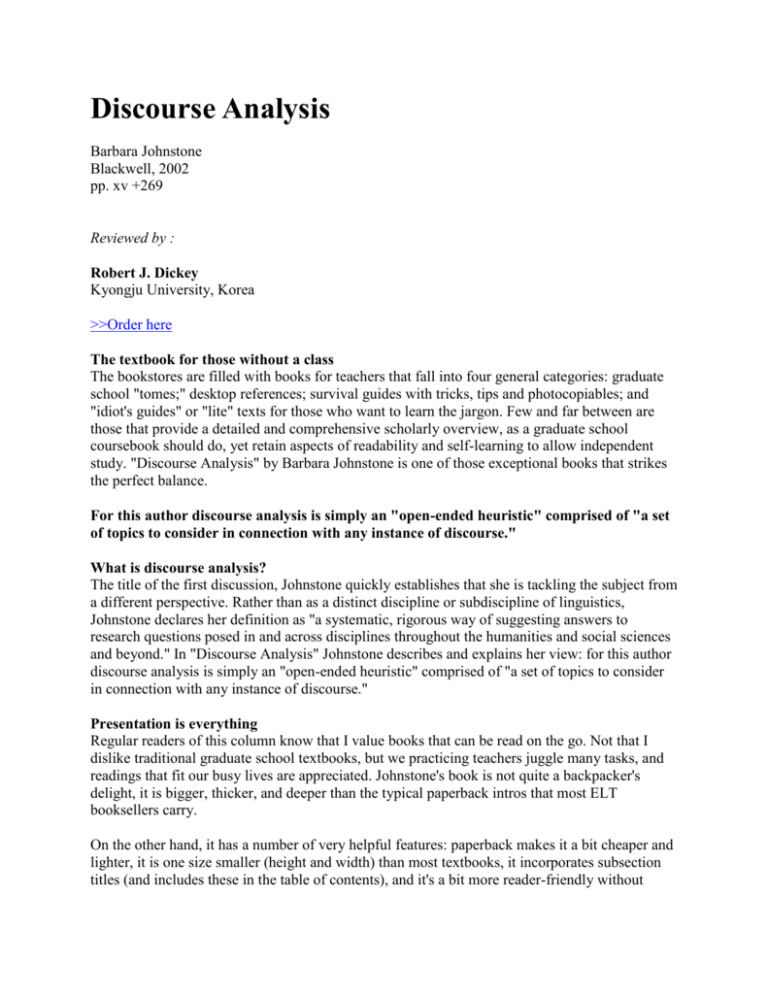
Discourse Analysis
Barbara Johnstone
Blackwell, 2002
pp. xv +269
Reviewed by :
Robert J. Dickey
Kyongju University, Korea
>>Order here
The textbook for those without a class
The bookstores are filled with books for teachers that fall into four general categories: graduate
school "tomes;" desktop references; survival guides with tricks, tips and photocopiables; and
"idiot's guides" or "lite" texts for those who want to learn the jargon. Few and far between are
those that provide a detailed and comprehensive scholarly overview, as a graduate school
coursebook should do, yet retain aspects of readability and self-learning to allow independent
study. "Discourse Analysis" by Barbara Johnstone is one of those exceptional books that strikes
the perfect balance.
For this author discourse analysis is simply an "open-ended heuristic" comprised of "a set
of topics to consider in connection with any instance of discourse."
What is discourse analysis?
The title of the first discussion, Johnstone quickly establishes that she is tackling the subject from
a different perspective. Rather than as a distinct discipline or subdiscipline of linguistics,
Johnstone declares her definition as "a systematic, rigorous way of suggesting answers to
research questions posed in and across disciplines throughout the humanities and social sciences
and beyond." In "Discourse Analysis" Johnstone describes and explains her view: for this author
discourse analysis is simply an "open-ended heuristic" comprised of "a set of topics to consider
in connection with any instance of discourse."
Presentation is everything
Regular readers of this column know that I value books that can be read on the go. Not that I
dislike traditional graduate school textbooks, but we practicing teachers juggle many tasks, and
readings that fit our busy lives are appreciated. Johnstone's book is not quite a backpacker's
delight, it is bigger, thicker, and deeper than the typical paperback intros that most ELT
booksellers carry.
On the other hand, it has a number of very helpful features: paperback makes it a bit cheaper and
lighter, it is one size smaller (height and width) than most textbooks, it incorporates subsection
titles (and includes these in the table of contents), and it's a bit more reader-friendly without
becoming the "Reader's Digest Condensed Books" version of a text. Yet it is a real textbook,
Johnstone notes this is a book for those taking their first (or only) book in discourse analysis at
the graduate level, coming in from a variety of majors (not just Linguistics/English
education/etc).
Guiding the reader
This subject area can be very difficult. At least, it is for me, so I looked for help. And found it.
As do many books, discussion questions encourage the reader to think more about the materials
presented. Discourse Analysis does it better, I think, because of the sheer volume of questions,
the variety of perspectives sought, and their placement. Coming at the end of subsections, we get
3-7 discussion questions every 5 pages or so. Some incorporate other languages, for students
who are in advanced studies in those languages, others feature everyday life situations. It's not
just "imagine a classroom of language students."
You know that "topic sentence" we encourage our language learners to write at the top of each
paragraph? Johnstone hasn't forgotten how useful they really are. Discourse Analysis is based on
all the features of an excellent roadmap: a good overview (table of contents), lots of landmarks
(subsection headers and topic sentences), and frequent reminders of what you just gone through
(discussion questions and integration into newer discussions).
Comprehensiveness
Because I'm not a scholar of discourse analysis, I can't claim that the book is fully
comprehensive. I can say that it addresses a wider variety of topics than some other books in the
market. Johnstone's broad definition of discourse analysis is part of this, she includes researchers
who probably aren't thought of as discourse analysts (even by themselves). Since most of us in
TEFL consider ourselves as far more multidisciplinary than those buried in the bowels of
linguistics, "Discourse Analysis" is probably more befitting our interests.
And all the details
Because this is not a 400-page textbook written in the condensed language of academia, scholars
could argue that some detail is lost. There is a rather higher than usual reliance on a few authors,
and the further reading bits at the end of each chapter are in narrative, rather than simply an
annotated booklist, which might account for some of that. The type is a bit smaller than some
popular teacher's resources, making it a tough read on the subway.
I am very disappointed in the 3.5 page Glossary, which is very insufficient despite Johnstone's
heroic efforts to define and explain terms in the narrative. And the index is rather insufficient,
much of it is only authors cited, and I think dividing into "author's index" and "general index"
serves much better, particularly if each are very inclusive. But at least this index lists more than
only the first instance of use of each term.
« More than a Native Speaker An Introduction for Volunteers Teaching English Abroad | Main |
Pragmatics »
Terjemahan Inggris ke Bahasa Indonesia
Buku pelajaran bagi mereka yang tanpa kelas
Toko buku penuh dengan buku-buku untuk guru-guru yang jatuh ke dalam empat kategori
umum: lulusan sekolah "buku-buku tebal;" desktop referensi; kelangsungan hidup panduan
dengan trik, tips dan photocopiables, dan "idiot's pemandu" atau "lite" teks bagi mereka yang
ingin mempelajari jargon. Sedikit dan jarang terjadi adalah mereka yang memberikan secara
terperinci dan komprehensif tinjauan ilmiah, sebagai coursebook pascasarjana harus dilakukan,
namun tetap mempertahankan aspek pembacaan dan belajar sendiri untuk memungkinkan belajar
mandiri. "Analisis Wacana" oleh Barbara Johnstone adalah salah satu buku luar biasa yang
menyerang keseimbangan sempurna.
Untuk analisis wacana penulis ini hanyalah sebuah "terbuka heuristik" terdiri dari "satu set topik
yang perlu dipertimbangkan dalam contoh sehubungan dengan wacana."
Apa itu analisis wacana?
Judul diskusi pertama, Johnstone cepat menetapkan bahwa dia adalah menangani subjek dari
perspektif yang berbeda. Alih-alih sebagai suatu disiplin atau subdiscipline linguistik, definisi
Johnstone menyatakan dirinya sebagai "yang sistematis, ketat menyarankan cara jawaban untuk
pertanyaan-pertanyaan penelitian yang diajukan dalam dan di seluruh disiplin ilmu humaniora
dan ilmu-ilmu sosial dan seterusnya." Dalam "Analisis Wacana" Johnstone menggambarkan dan
menjelaskan pandangannya: untuk analisis wacana penulis ini hanyalah sebuah "terbuka
heuristik" terdiri dari "satu set topik yang perlu dipertimbangkan dalam contoh sehubungan
dengan wacana."
Presentasi adalah segalanya
Reguler pembaca kolom ini tahu bahwa aku nilai buku yang dapat dibaca di mana saja. Bukan
berarti saya tidak suka buku pelajaran sekolah lulus tradisional, tapi kami berlatih guru
menangani banyak tugas, dan bacaan yang sesuai dengan kehidupan sibuk kita dihargai.
Johnstone buku ini tidak cukup backpacker senang, itu adalah lebih besar, lebih tebal, dan lebih
dalam daripada novel khas intro bahwa sebagian besar penjual buku ELT bawa.
Di sisi lain, ia memiliki sejumlah fitur yang sangat membantu: paperback membuat sedikit lebih
murah dan lebih ringan, itu adalah satu ukuran lebih kecil (tinggi dan lebar) daripada kebanyakan
buku teks, ia memasukkan judul ayat (dan ini termasuk dalam daftar isi ), dan ini sedikit lebih
pembaca-ramah tanpa menjadi "Reader's Digest Condensed Books" versi teks. Namun itu benarbenar buku teks, catatan Johnstone buku ini adalah bagi mereka yang mengambil pertama
mereka (atau hanya) buku dalam analisis wacana di tingkat sarjana, yang datang dari berbagai
jurusan (bukan hanya Linguistik / inggris pendidikan / dll).
Membimbing pembaca
Area subyek ini dapat menjadi sangat sulit. Setidaknya, itu untuk saya, jadi saya mencari
bantuan. Dan menemukannya. Seperti melakukan banyak buku, pertanyaan diskusi mendorong
pembaca untuk berpikir lebih tentang materi yang disajikan. Analisis wacana tidak lebih baik,
saya kira, karena volume yang murni pertanyaan, berbagai perspektif dicari, dan penempatan.
Datang di akhir subbagian, kita mendapatkan pertanyaan setiap 3-7 diskusi 5 halaman atau lebih.
Menggabungkan beberapa bahasa lain, bagi siswa yang berada di studi lanjutan dalam bahasabahasa itu, fitur lain situasi kehidupan sehari-hari. Bukan hanya "membayangkan sebuah kelas
dengan siswa bahasa."
Anda tahu bahwa "topik kalimat" kami mendorong para pembelajar bahasa kita untuk menulis di
bagian atas setiap ayat? Johnstone tidak lupa bagaimana mereka sebenarnya berguna. Analisis
Wacana didasarkan pada semua fitur peta jalan yang sempurna: sebuah tinjauan yang baik
(daftar isi), banyak tengara (seksi header dan topik kalimat), dan sering pengingat dari apa yang
baru saja mengalami (diskusi pertanyaan dan integrasi ke dalam diskusi yang lebih baru ).
Kelengkapan
Karena aku bukan sarjana analisis wacana, saya tidak bisa mengklaim bahwa buku ini
sepenuhnya komprehensif. Saya dapat mengatakan bahwa alamat yang lebih luas berbagai topik
dari buku-buku lain di pasar. Johnstone adalah definisi yang luas dari analisis wacana merupakan
bagian dari ini, ia termasuk peneliti yang mungkin tidak dianggap sebagai analis wacana (bahkan
oleh diri mereka sendiri). Karena kebanyakan dari kita dalam TEFL menganggap diri kita jauh
lebih multi-disiplin daripada yang terkubur di dalam perut linguistik, "Analisis Wacana"
mungkin lebih layak bagi kepentingan kita.
Dan semua rincian
Karena ini bukan buku 400 halaman ditulis dalam bahasa kental akademisi, sarjana bisa
berpendapat bahwa beberapa detail yang hilang. Ada yang agak lebih tinggi dari biasanya
bergantung pada beberapa penulis, dan bahan bacaan lebih lanjut bit pada akhir setiap bab yang
di narasi, bukan sekadar sebuah catatan Booklist, yang mungkin menjelaskan beberapa hal itu.
Jenis ini sedikit lebih kecil daripada beberapa sumber daya guru populer, membuatnya menjadi
sulit membaca di kereta bawah tanah.
Saya sangat kecewa pada halaman 3,5 Glossary, yang sangat tidak memadai heroik Johnstone
meskipun upaya untuk mendefinisikan dan menjelaskan istilah-istilah dalam narasi. Dan indeks
agak tidak memadai, sebagian besar hanya penulis dikutip, dan kurasa membagi menjadi "indeks
pengarang" dan "indeks umum" melayani jauh lebih baik, terutama jika masing-masing sangat
inklusif. Tapi setidaknya daftar indeks ini lebih dari hanya contoh pertama penggunaan setiap
istilah.
How to Teach Speaking
Exploring Second Language Classroom Research
Succeeding with English Language Learners
Teaching English Language Learners
Language Activities for Teenagers
New Perspectives on Grammar Teaching in Second Language Classrooms
Fossilization in Adult Second Language Acquisition
Practical English Language Teaching
How Languages are Learned
Teaching Language: From Grammar to Grammaring
>>View All
Examiner Training - Cambridge ESOL workshop: Young Learners -- January 10 (Sun) -Okayama
Eureka! Finding a direction forward with research planning -- January 10 (Sun) -- Omiya,
Saitama
Facilitating Technology-Enhanced Active Learning Strategies on Your Campus -- January 10
(Sun) -- Tokyo
411
International
Washington Post
USA Today
The Times
The Guardian
The Independent
The Sun
TIME.com
CNN.com
BBC Online
Japan
The Japan Times
Asahi Evening News
Daily Yomiuri
Nikkei Net
Japan Today
HOME | Columns | Subjects | Features | Jobs | Message Board | Store (Books | Magazines +
More)
ELT News is the website for teaching English in Japan and for those looking for English
teaching jobs in Japan. If you're involved in the English Language Teaching (ELT) Industry in
Japan, then this site is your home. If you're looking for an English teaching job or another
English-related job in Japan, check out our teaching jobs section.
Copyright © 2000-2010 eigoTown.com, Limited. All rights reserved.
All other trademarks are the sole property of their respective owners.
Unless otherwise stated, the various content on this website remains the copyright of the
respective individual creator(s) and may not be reproduced without the permission of the
respective individual creator(s).

